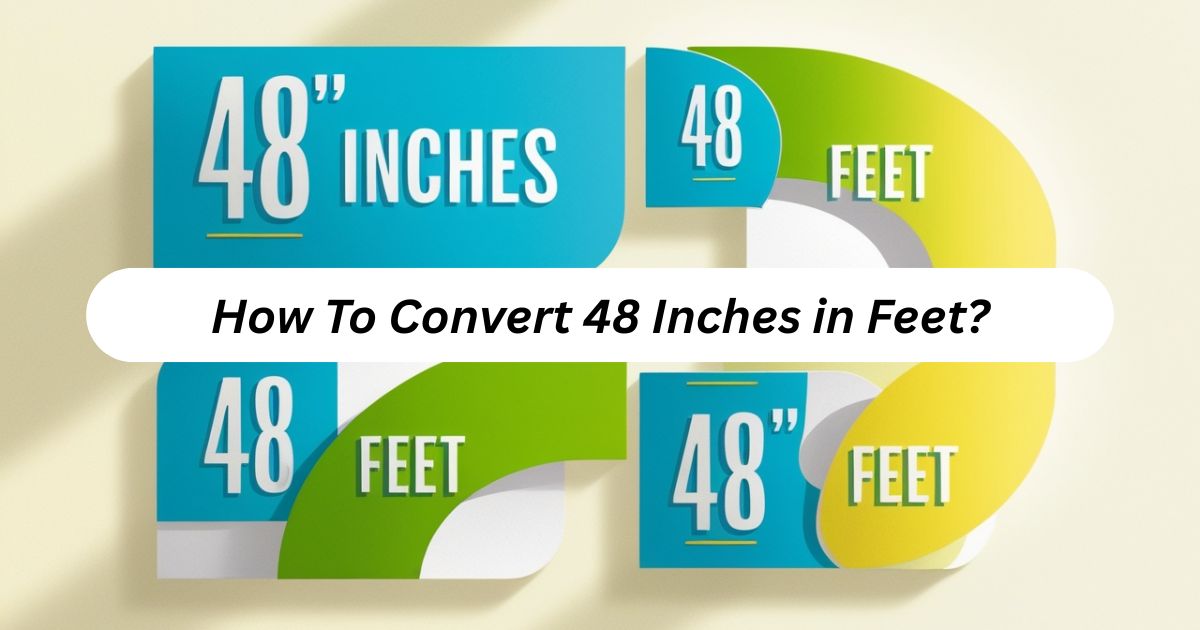Master the Art of Converting 48 Inches to Feet: The Complete Professional Guide
Converting measurements accurately represents a fundamental skill that impacts countless professional and personal endeavors. Understanding how to convert 48 inches to feet serves as the foundation for mastering unit conversion within the imperial system. This comprehensive guide provides the essential knowledge needed to perform these measurements with confidence and precision.
The Essential Foundation: Understanding Inch-to-Foot Conversion Mathematics
The conversion formula for transforming inches to feet relies on a simple mathematical relationship established within the imperial system. This foundational principle states that 1 foot equals 12 inches, creating the basic ratio used for all inch to foot conversion calculations.
48 inches divided by 12 inches equals 4 feet exactly. This calculation demonstrates the straightforward nature of the inches to feet conversion process. The mathematical precision required for professional applications demands understanding this core relationship thoroughly.
Professional contractors, architects, and engineers depend on this measurement conversion accuracy daily. Their projects require exact specifications where even minor errors can result in significant cost overruns or structural problems. The convert inches to feet formula provides the reliability these industries demand.
Step-by-Step Conversion Process: Transforming 48 Inches to Feet
Converting 48 inches in feet requires following a systematic approach that ensures accuracy every time. Begin by identifying the measurement requiring conversion, which in this case equals 48 inches.
Apply the fundamental conversion formula by dividing the inch measurement by twelve. This calculation yields 48 inches ÷ 12 inches = 4 feet with no remainder. The clean result indicates a perfect conversion without fractional components.
Verify your calculation by reversing the process. Multiply 4 feet by 12 inches to confirm the result equals 48 inches. This verification step prevents errors that could compromise project accuracy.
Professional measurement practices emphasize double-checking calculations, particularly when working with critical dimensions. The 48 in to ft conversion serves as an excellent example of how systematic approaches yield reliable results.
Professional Industry Applications: Where This Conversion Matters Most

Understanding how many feet in 48 inches proves essential across numerous professional sectors. Each industry applies this knowledge differently, yet the fundamental measurement accuracy requirements remain constant.
Construction professionals encounter 48 inches measurements frequently when working with standard building materials. Door frames, window openings, and structural components often utilize this dimension. Converting to 4 feet helps visualize spacing requirements and material ordering needs.
Fashion designers work with fabric widths commonly measuring 48 inches, which equals 4 feet. This conversion helps calculate yardage requirements and determine pattern layout efficiency. Accurate measurements prevent material waste and ensure proper garment construction.
The real estate industry relies on precise room measurement in feet for property descriptions and space planning. Converting 48 inches to 4 feet helps agents and buyers understand spatial relationships and furniture placement possibilities.
Construction and Architecture: Precision in Building Projects
Construction projects demand exceptional measurement accuracy where 48 inches conversions appear throughout the building process. Blueprints specify dimensions that require conversion between inches and feet for different phases of work.
Structural framing often incorporates 48 inches spacing for efficiency and code compliance. Understanding this measurement equals 4 feet helps crews visualize layouts and maintain proper structural integrity. Construction measurement conversion accuracy prevents costly material waste and rework.
Architecture professionals create detailed drawings that specify dimensions in both inches and feet depending on the scale and application. Converting 48 inches in feet ensures consistency across all project documentation and coordination between trades.
Building inspectors verify that construction projects meet code requirements through precise measurements. The ability to convert 48 inches to 4 feet quickly facilitates efficient inspections and accurate compliance verification.
Interior Design and Space Planning: Creating Functional Environments
Interior design professionals utilize 48 inches measurements extensively when planning room layout and furniture sizing. Standard furniture pieces often measure 48 inches wide, requiring conversion to 4 feet for accurate space planning.
Kitchen islands frequently measure 48 inches in length, which equals 4 feet. This conversion helps designers ensure adequate clearance around the island while maintaining proper traffic flow patterns. Home improvement measurements depend on this accuracy for successful installations.
Window treatments and drapery specifications often reference 48 inches widths. Converting to 4 feet helps clients visualize coverage areas and determine fabric requirements for custom treatments. Measuring tape inches to feet conversions streamline the design process.
Storage solutions and built-in cabinetry incorporate 48 inches dimensions regularly. Understanding this equals 4 feet enables designers to create functional storage that maximizes available space while meeting client requirements.
Manufacturing and Quality Control: Maintaining Production Standards
Manufacturing environments require precise measurement conversion capabilities where 48 inches specifications appear across various products and processes. Quality control procedures depend on accurate unit conversion to maintain production standards.
Production machinery settings often specify 48 inches dimensions for material handling and processing. Converting to 4 feet helps operators understand equipment capabilities and maintain proper clearances. Imperial unit conversion accuracy ensures consistent product quality.
Packaging and shipping requirements frequently involve 48 inches measurements that require conversion to 4 feet for logistics planning. Transportation companies utilize these conversions to optimize loading efficiency and determine shipping classifications.
Material specifications from suppliers may list dimensions in inches while production requirements specify feet. Converting 48 inches to 4 feet ensures accurate material ordering and inventory management throughout the manufacturing process.
Retail and Commercial Space Management: Optimizing Layout Efficiency

Retail environments utilize 48 inches measurements extensively for fixture placement and customer flow optimization. Store displays measuring 48 inches wide equal 4 feet, which impacts aisle width calculations and accessibility compliance.
Commercial space planners convert 48 inches in feet to determine optimal layout configurations that maximize product display while maintaining comfortable shopping experiences. Measurement accuracy directly impacts sales performance and customer satisfaction.
Visual merchandising professionals work with display fixtures commonly measuring 48 inches in various dimensions. Converting to 4 feet helps create balanced presentations that attract customer attention while maximizing product exposure.
Warehouse and distribution facilities incorporate 48 inches spacing standards for equipment and material handling. Understanding this equals 4 feet facilitates efficient operations and safety compliance throughout the facility.
Digital Conversion Tools and Modern Technology Solutions
Modern inches to feet calculator applications provide instant measurement conversion capabilities for professionals requiring quick and accurate results. These online converters eliminate manual calculations while maintaining precision standards.
Smartphone apps designed for construction, interior design, and engineering professionals incorporate comprehensive conversion charts that include 48 inches to feet calculations among numerous other measurement options.
Professional calculator functions specifically designed for imperial unit conversion streamline complex calculations involving multiple measurements. These tools prevent errors that could compromise project accuracy and professional credibility.
Digital measuring tape inches to feet converters provide real-time conversion capabilities that enhance field measurement efficiency. These technologies integrate seamlessly into existing workflows while improving accuracy and reducing calculation time.
Critical Conversion Errors That Compromise Accuracy
Common conversion mistakes occur when professionals forget the fundamental relationship that 1 foot equals 12 inches. Multiplying instead of dividing represents the most frequent error when converting 48 inches to feet.
Rounding errors compromise accuracy when performed too early in the calculation process. Complete the entire 48 inches in feet conversion before applying any rounding rules to maintain precision throughout professional applications.
Confusing the direction of conversion leads to dramatically incorrect results. Remember that converting inches to feet always requires division by twelve, while converting feet to inches requires multiplication by twelve.
Manual calculations without verification increase error likelihood, particularly when working with critical measurements. Always double-check 48 in to ft conversions using alternative methods or digital tools when accuracy matters most.
Advanced Conversion Techniques for Complex Measurements
Converting larger measurements like 120 inches to 10 feet follows the same principles as 48 inches conversions but requires additional attention to detail. Systematic approaches ensure accuracy regardless of measurement magnitude.
130 inches converts to 10 feet 10 inches when properly calculated, demonstrating how to handle measurements that don’t divide evenly by twelve. Professional applications often require expressing results in this mixed format rather than decimal values.
Conversion charts provide quick reference capabilities for frequently used measurements. Creating custom charts that include 48 inches to 4 feet conversions alongside other common measurements improves workflow efficiency.
Advanced measurement techniques incorporate tolerance considerations and precision requirements specific to each application. Understanding when to use feet and inches breakdown versus decimal formats depends on industry standards and project specifications.
Historical Context: Why the Imperial System Uses 12-Inch Feet

The imperial system developed over centuries through practical applications and historical traditions that established 12 inches as the standard foot measurement. This system predates metric alternatives and remains prevalent throughout numerous industries.
Historical measurement standards evolved from human anatomy references and practical subdivision needs. The twelve-inch foot provided convenient fractions that facilitated construction and trade applications before modern measurement tools existed.
Understanding why 48 inches equals 4 feet requires appreciating the mathematical elegance of twelve-based divisions. This system allows for easy subdivision into halves, thirds, quarters, and sixths without creating complex fractional results.
Contemporary US measurement system applications maintain these historical standards while incorporating modern precision requirements. Professional industries continue utilizing inches and feet because of their practical advantages in specific applications.
International Measurement Standards and Global Applications
Global industries often encounter mixed measurement systems where 48 inches conversions to 4 feet facilitate international collaboration and communication. Understanding both imperial and metric systems enhances professional versatility.
Converting inches to feet skills translate directly to metric conversions when working with international partners. The systematic approach used for 48 inches in feet calculations applies equally to centimeter and meter conversions.
Export and import industries frequently require measurement conversion capabilities between systems. Products manufactured using 48 inches specifications must be converted accurately for international markets and regulatory compliance.
Professional standards organizations establish conversion protocols that ensure accuracy across different measurement systems. These standards govern how 48 in to ft conversions integrate with metric equivalents in global applications.
Cost Implications of Measurement Errors in Professional Settings
Construction projects experience significant cost impacts when measurement errors occur during material ordering or installation phases. Converting 48 inches incorrectly to something other than 4 feet can result in expensive rework and delays.
Manufacturing errors stemming from incorrect unit conversion create quality problems that impact customer satisfaction and company reputation. Accurate 48 inches to 4 feet conversions prevent costly production mistakes and material waste.
Professional liability considerations emphasize the importance of accurate measurements in all applications. Engineering and architecture firms maintain strict quality control procedures to prevent conversion errors from compromising project safety.
Time management benefits result from mastering inches to feet conversion skills that eliminate repeated calculations and verification steps. Professionals who convert 48 inches in feet quickly and accurately maintain competitive advantages.
Teaching Conversion Skills: Educational Approaches That Work
Effective measurement education emphasizes understanding the fundamental relationship between inches and feet rather than memorizing conversion tables. Students who grasp that 48 inches equals 4 feet through division develop transferable skills.
Visual learning techniques help students understand 48 inches measurements by relating them to familiar objects that measure 4 feet. Real-world examples from construction, sports, and daily life reinforce the conversion concept.
Practice exercises incorporating DIY project measurements and home improvement scenarios provide relevant contexts for learning inches to feet conversion skills. Students retain knowledge better when applications connect to their personal experiences.
Assessment methods should evaluate both calculation accuracy and practical application understanding. Students must demonstrate ability to convert 48 inches to 4 feet while explaining when and why this conversion matters in professional contexts.
Quality Assurance: Verification Methods for Critical Measurements
Professional measurement verification requires multiple methods to ensure accuracy when converting 48 inches to 4 feet. Critical applications demand redundant checking procedures that prevent costly errors.
Field verification techniques include using different measuring tape tools and comparing results from multiple technicians. Construction projects particularly benefit from independent measurement verification before proceeding with expensive installations.
Documentation standards require recording both original inch measurements and converted feet values with clear identification of conversion methods used. This creates audit trails that support quality assurance programs.
Calibration procedures for measurement tools ensure accuracy throughout the conversion process. Regular equipment verification maintains confidence in 48 inches to 4 feet calculations across all applications.
Expert Insights: Professional Best Practices and Industry Standards

Industry professionals recommend developing systematic approaches to measurement conversion that minimize error opportunities. Converting 48 inches to 4 feet should follow established procedures consistently across all projects.
Construction veterans emphasize the importance of visualizing measurements in both inches and feet to catch obvious errors before they impact project progress. This dual perspective helps identify conversion mistakes quickly.
Interior design experts suggest creating reference materials that include common measurements like 48 inches converted to 4 feet alongside relevant application examples. These resources improve efficiency while maintaining accuracy.
Professional development programs increasingly emphasize measurement skills as fundamental competencies required for career advancement. Mastering inches to feet conversion capabilities demonstrates attention to detail and technical proficiency.
FAQ’s
What is 48 inches in feet and inches?
The answer is exactly 4 feet with no remaining inches. This clean conversion occurs because 48 inches divides evenly by 12 inches per foot.
Why divide inches by 12 when converting to feet?
The imperial system defines 1 foot as containing exactly 12 inches, establishing this as the fundamental conversion ratio for all inch to foot conversion calculations.
How to manually convert inches to feet without a calculator?
Divide the inch measurement by twelve using basic division skills. For 48 inches, calculate 48 ÷ 12 = 4 feet through standard mathematical procedures.
What tools help with converting inches without calculator assistance?
Conversion charts, reference tables, and memorized common conversions like 48 inches equals 4 feet provide quick answers without requiring calculations.
Why focus on measurement accuracy in professional applications?
Errors in unit conversion create costly problems ranging from material waste to safety hazards. Accurate measurements form the foundation of successful projects across all industries.
Future-Proofing Your Measurement Skills: Staying Current with Industry Changes
Technology integration continues evolving within measurement applications, yet the fundamental 48 inches to 4 feet conversion relationship remains constant. Professional development requires balancing traditional skills with modern tools.
Industry automation increasingly incorporates measurement conversion capabilities, but professionals must understand underlying principles to verify automated results. Knowing that 48 inches equals 4 feet enables effective technology utilization.
Emerging applications in virtual reality and augmented reality rely on accurate measurements for creating realistic environments. Converting inches to feet skills translate directly to these advanced technologies.
Professional competency in measurement continues providing career advantages as industries increasingly value precision and accuracy. Mastering 48 inches in feet conversions demonstrates fundamental technical capabilities that employers seek across multiple sectors.
The ability to convert 48 inches to feet represents more than simple mathematics—it embodies the precision and attention to detail that characterize successful professionals across numerous industries. Whether working in construction, interior design, manufacturing, or any field requiring accurate measurements, this fundamental skill provides the foundation for professional excellence and project success.











